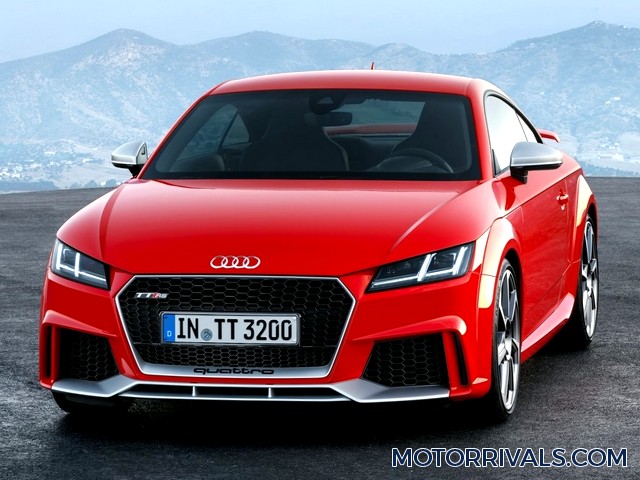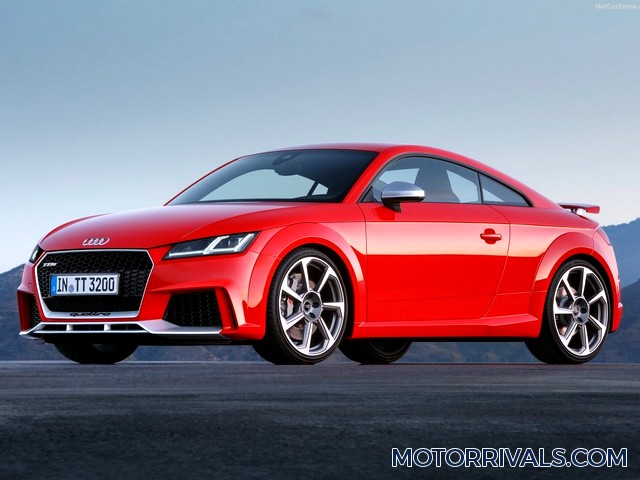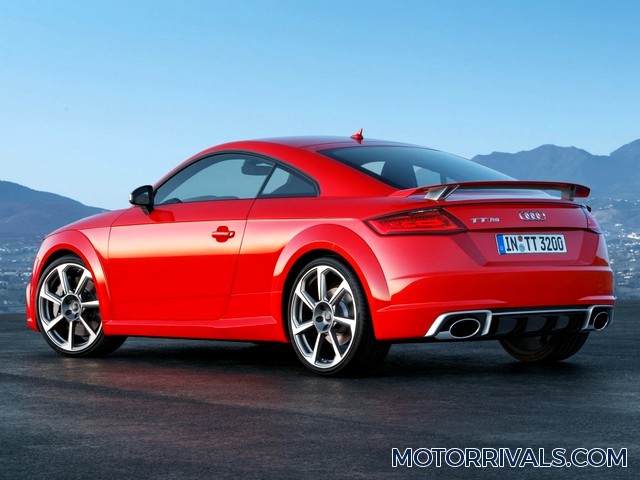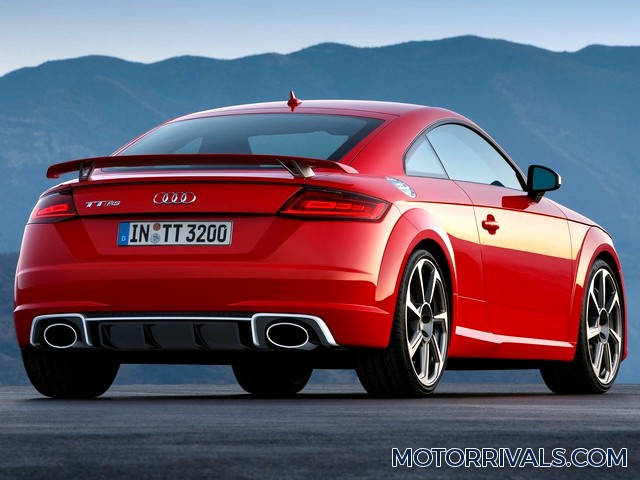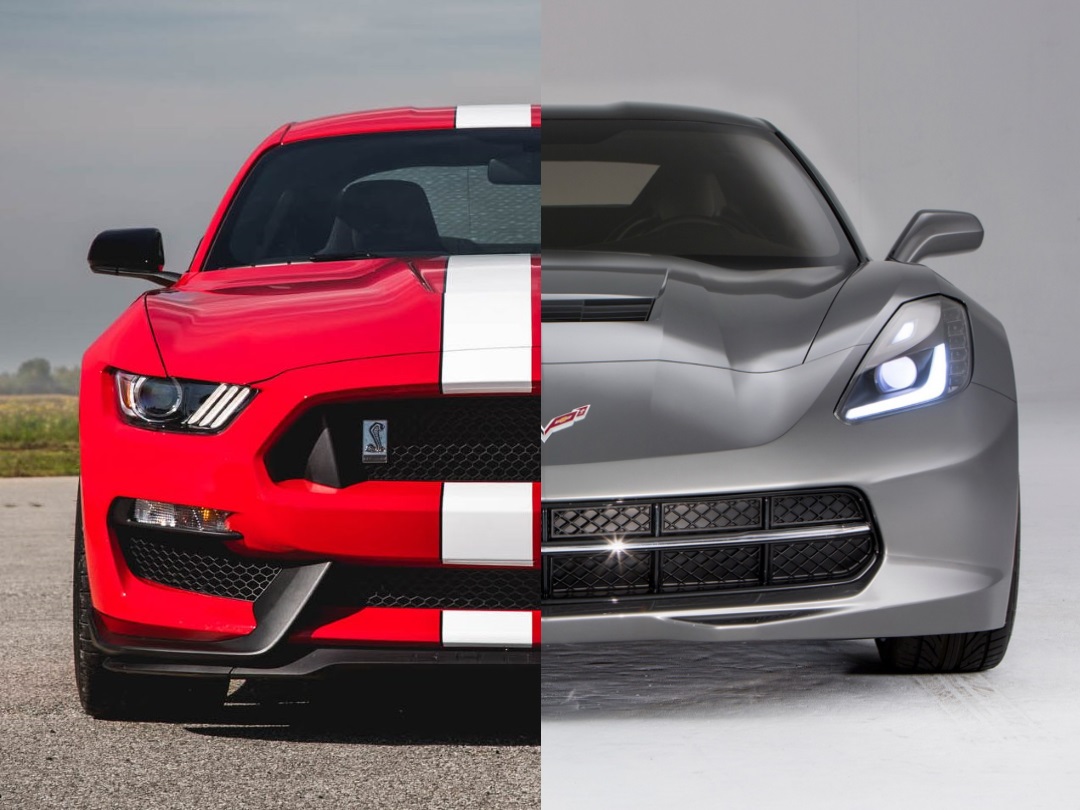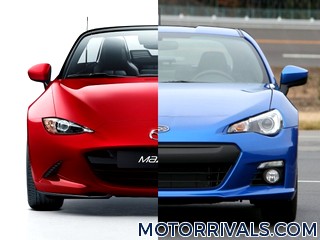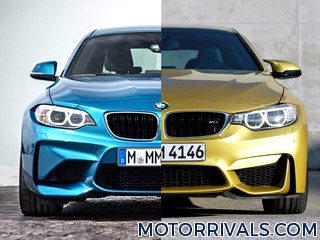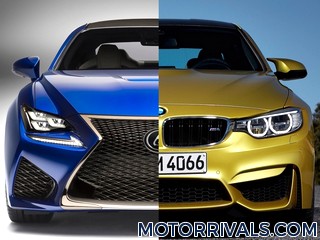2017 Audi TT RS vs 2016 BMW M2
Audi Press Release Highlights
As the sporty spearhead of the TT series, the new TT RS is to be
marketed under the Audi Sport label. Large air inlets, a Single frame
grille with a newly designed honeycomb grille and quattro logo, a fixed
rear wing and two large, oval exhaust tailpipes – the new TT RS Coupé
and the new TT RS Roadster exude concentrated power. Along the flanks,
aerodynamically-shaped side sills emphasize the dynamic design. Both
models measure 4.19 meters (13.9 ft) in length, 1.83 meters (6 ft) in
width and 1.34 meters (4.5 ft) in height.
The forces of the 2.5 TFSI engine flow via a seven-speed S tronic, which shifts at lightning speed, to the quattro permanent all-wheel drive. Its multi-plate clutch distributes the power freely between the axles. This provides strong grip and immense driving pleasure. The wheel-selective torque control makes handling even more agile and safe. Using the Audi drive select system, the driver can influence the quattro drive and other components such as the steering, S tronic, engine characteristic and exhaust flaps. The four modes available for this are comfort, auto, dynamic, and individual.
Controls and display in the new TT RS are focused completely on the driver. All information is displayed as standard on the fully digital Audi virtual cockpit with 12.3-inch screen. The driver can choose from three views, including a special RS screen that highlights the rev counter and provides information on tire pressure, torque, and g‑force, among other things. The Audi virtual cockpit also displays a shift light which informs the driver that the engine speed limit has been reached. For the first time in the RS portfolio, the RS sport leather steering wheel with shift paddles has two operating satellite buttons for turning the engine on and off as well as the driving dynamics system known as Audi drive select, in addition to multifunction buttons. This means that the driver’s hands stay on the wheel at all times. The driver can influence the exhaust flap control via the sound button on the center console.
Audi also offers a huge amount of high-end infotainment technology. The options include MMI navigation plus with MMI touch including free text search and natural voice control, as well as the Audi connect online module with Wi-Fi hotspot. Using Audi phone box, compatible cell phones can be charged inductively and paired with the onboard antennae for optimal reception. The new Audi smartphone interface technology displays selected apps from the cell phone directly in the Audi virtual cockpit. The Bang & Olufsen sound system is a highlight for fans of excellent acoustics.
Powertrain
A jury of international motor journalists has voted the 2.5 TFSI “Engine of the Year” six times in a row. Now Audi has further developed the five-cylinder engine in all areas – with lightweight construction measures, reduced internal friction and increased power delivery. As a result, the turbo engine gains a good 17 percent increase in performance at an unchanged capacity of 2,480 cc. At 294 kW (400 hp), it is more powerful than ever before. The maximum torque of 480 Nm (354.0 lb-ft) is available between 1,700 and 5,850 rpm. It ensures fantastic pulling power, which accompanies the unmistakable sound. Cylinders positioned directly beside each other and far away from each other fire in alternation. This brings with it a very special rhythm. The TT RS Coupé accelerates from 0 to 100 km/h (0 to 62.1 mph) in 3.7 seconds, the Roadster in 3.9 seconds – this corresponds to the level of a supercar. Audi regulates the top speed at 250 km/h (155.3 mph), or at 280 km/h (173.9 mph) upon request.The forces of the 2.5 TFSI engine flow via a seven-speed S tronic, which shifts at lightning speed, to the quattro permanent all-wheel drive. Its multi-plate clutch distributes the power freely between the axles. This provides strong grip and immense driving pleasure. The wheel-selective torque control makes handling even more agile and safe. Using the Audi drive select system, the driver can influence the quattro drive and other components such as the steering, S tronic, engine characteristic and exhaust flaps. The four modes available for this are comfort, auto, dynamic, and individual.
Chassis
In addition to its light weight, the Audi TT RS has its sporty chassis to thank for its outstanding handling. The direct steering provides close contact with the road and makes it a pleasure to drive challenging winding stretches. At the front axle, ventilated and perforated steel discs are in action behind the 19-inch wheels – or 20-inch forged lightweight wheels as an option. Alternatively, lighter and particularly abrasion-resistant carbon-fiber ceramic discs are available. At the back, a steel monoblock disc is used. As an option, Audi supplies RS sport suspension plus adaptive dampers in magnetic ride technology. In this case, the damping characteristics can be influenced electronically. The control technology is integrated into the driving dynamics system known as Audi drive select.Technology
For the first time in a series-production Audi, Matrix OLED technology (organic light emitting diode) is used in the rear lights as an option. These emit an extremely homogeneous, high-contrast light. The light can be continuously dimmed, it does not cast any shadows and does not require any reflectors – this makes the OLEDs in 3D design efficient, light and visually impressive. Each rear light contains four wafer-thin units which become smaller from the inside out. The biggest bears the TT logo and the four Audi rings. The TT RS has LED rear lights and LED headlights as standard. Alternatively, the latter are available as intelligently controlled Matrix LED units.Controls and display in the new TT RS are focused completely on the driver. All information is displayed as standard on the fully digital Audi virtual cockpit with 12.3-inch screen. The driver can choose from three views, including a special RS screen that highlights the rev counter and provides information on tire pressure, torque, and g‑force, among other things. The Audi virtual cockpit also displays a shift light which informs the driver that the engine speed limit has been reached. For the first time in the RS portfolio, the RS sport leather steering wheel with shift paddles has two operating satellite buttons for turning the engine on and off as well as the driving dynamics system known as Audi drive select, in addition to multifunction buttons. This means that the driver’s hands stay on the wheel at all times. The driver can influence the exhaust flap control via the sound button on the center console.
Audi also offers a huge amount of high-end infotainment technology. The options include MMI navigation plus with MMI touch including free text search and natural voice control, as well as the Audi connect online module with Wi-Fi hotspot. Using Audi phone box, compatible cell phones can be charged inductively and paired with the onboard antennae for optimal reception. The new Audi smartphone interface technology displays selected apps from the cell phone directly in the Audi virtual cockpit. The Bang & Olufsen sound system is a highlight for fans of excellent acoustics.
BMW Press Release Highlights
A single glance is all it takes to pick the new BMW M2 Coupe out as a
member of the BMW M family, with its styling also keen to advertise its
dynamic attributes. Inspired by models from the history of BMW in motor
racing, the new M2 Coupe makes no secret of its extraordinary
performance potential. The new BMW M2 Coupe is not only the direct heir
to the successful BMW 1-Series M Coupe, but also - in its underlying
philosophy - a descendant of the original E30 BMW M3 and the BMW 2002
turbo. The latter caused a sensation over 40 years ago, embodying the
commitment of what is now BMW M GmbH to outstanding dynamics, unbeatable
agility and optimal car control.
The six-cylinder engine under the bonnet of the new compact BMW M2 is in keeping with the finest BMW M tradition, ensuring unbeatable driving fun on the race track yet at the same time doing everything you need it to in everyday use. It promises an insatiable appetite for revs for a turbocharged engine, offers exceptionally linear power delivery across a broad rev range and raises pulses with its distinctive engine sound. Add to the mix outstanding torque, available across a wide rev band, and - thanks to innovative M TwinPower Turbo technology - rapid responses and excellent efficiency.
The newly developed, three-litre six-cylinder in-line engine in the new BMW M2 deploys cutting-edge M TwinPower Turbo technology to develop 272 kW/370 hp at 6,500 rpm (fuel consumption combined: 8.5 l/100 km [33.2 mpg imp]; CO2 emissions combined: 199 g/km) and, in so doing, lays down a marker in the high-performance compact sports car segment. The same applies to power delivery. Peak torque of 465 Nm (343 lb-ft) can be increased to as much as 500 Nm (369 lb-ft) in short bursts under overboost. All of which enables the new BMW M2 Coupe with optional seven-speed M Double Clutch Transmission (M DCT) and Launch Control to accelerate from 0 to 100 km/h (62 mph) in just 4.3 seconds. Top speed is electronically limited to 250 km/h (155 mph).
The new BMW M2 Coupe comes as standard with a six-speed manual gearbox, which stands out with its compact design and low weight. The use of a new type of carbon-fibre friction lining enhances shift comfort. Dry-sump lubrication prevents any sloshing of the transmission oil and ensures all components benefit from an efficient supply of oil. An engagement speed control function, which blips the throttle on downshifts and lowers the engine's revs on upshifts, makes gear changes even smoother and lends the car additional stability during hard driving on the track.
In order to ensure extremely precise wheel location, play-free ball joints are used to transmit transverse forces. The stiffening plate and additional bolted connection between the axle subframe and the body sills, which increases the stiffness of the front-end structure, also has a positive influence here. The longitudinal forces passing through the suspension are transmitted into the torque struts directly via special elastomer bearings, and this delivers the desired rolling comfort at the same time.
All the control arms and wheel carriers of the new BMW M2's five-link rear axle are made from forged aluminium, which reduces the unsprung masses of the wheel-locating components by around three kilograms compared to a steel construction. In addition, a racing-derived rigid connection, dispensing with rubber bushings, is used to fix the lightweight steel grid-type rear axle subframe to the body. This further improves wheel location and tracking stability. The axle kinematics - which govern the movement of the wheels under compression according to the arrangement of the control arms - are likewise tuned to deliver the precise wheel location familiar from M cars.
Powertrain
The six-cylinder engine under the bonnet of the new compact BMW M2 is in keeping with the finest BMW M tradition, ensuring unbeatable driving fun on the race track yet at the same time doing everything you need it to in everyday use. It promises an insatiable appetite for revs for a turbocharged engine, offers exceptionally linear power delivery across a broad rev range and raises pulses with its distinctive engine sound. Add to the mix outstanding torque, available across a wide rev band, and - thanks to innovative M TwinPower Turbo technology - rapid responses and excellent efficiency.
The newly developed, three-litre six-cylinder in-line engine in the new BMW M2 deploys cutting-edge M TwinPower Turbo technology to develop 272 kW/370 hp at 6,500 rpm (fuel consumption combined: 8.5 l/100 km [33.2 mpg imp]; CO2 emissions combined: 199 g/km) and, in so doing, lays down a marker in the high-performance compact sports car segment. The same applies to power delivery. Peak torque of 465 Nm (343 lb-ft) can be increased to as much as 500 Nm (369 lb-ft) in short bursts under overboost. All of which enables the new BMW M2 Coupe with optional seven-speed M Double Clutch Transmission (M DCT) and Launch Control to accelerate from 0 to 100 km/h (62 mph) in just 4.3 seconds. Top speed is electronically limited to 250 km/h (155 mph).
The new BMW M2 Coupe comes as standard with a six-speed manual gearbox, which stands out with its compact design and low weight. The use of a new type of carbon-fibre friction lining enhances shift comfort. Dry-sump lubrication prevents any sloshing of the transmission oil and ensures all components benefit from an efficient supply of oil. An engagement speed control function, which blips the throttle on downshifts and lowers the engine's revs on upshifts, makes gear changes even smoother and lends the car additional stability during hard driving on the track.
Chassis
The basic requirement for top-level driving dynamics is a high level of rigidity and a low axle system weight. That's why the BMW M GmbH engineers have referred back to the lightweight aluminium front and rear axles of the BMW M3/M4 models for the new BMW M2 Coupe. For example, just the control arms, wheel carriers, axle subframes and stiffening plate of the double-joint spring-strut front axle weigh five kilograms less than would be the case with a conventional steel construction. Further weight savings are provided by the aluminium suspension struts and tubular anti-roll bar.In order to ensure extremely precise wheel location, play-free ball joints are used to transmit transverse forces. The stiffening plate and additional bolted connection between the axle subframe and the body sills, which increases the stiffness of the front-end structure, also has a positive influence here. The longitudinal forces passing through the suspension are transmitted into the torque struts directly via special elastomer bearings, and this delivers the desired rolling comfort at the same time.
All the control arms and wheel carriers of the new BMW M2's five-link rear axle are made from forged aluminium, which reduces the unsprung masses of the wheel-locating components by around three kilograms compared to a steel construction. In addition, a racing-derived rigid connection, dispensing with rubber bushings, is used to fix the lightweight steel grid-type rear axle subframe to the body. This further improves wheel location and tracking stability. The axle kinematics - which govern the movement of the wheels under compression according to the arrangement of the control arms - are likewise tuned to deliver the precise wheel location familiar from M cars.





